How Sleep Helps with Weight Loss
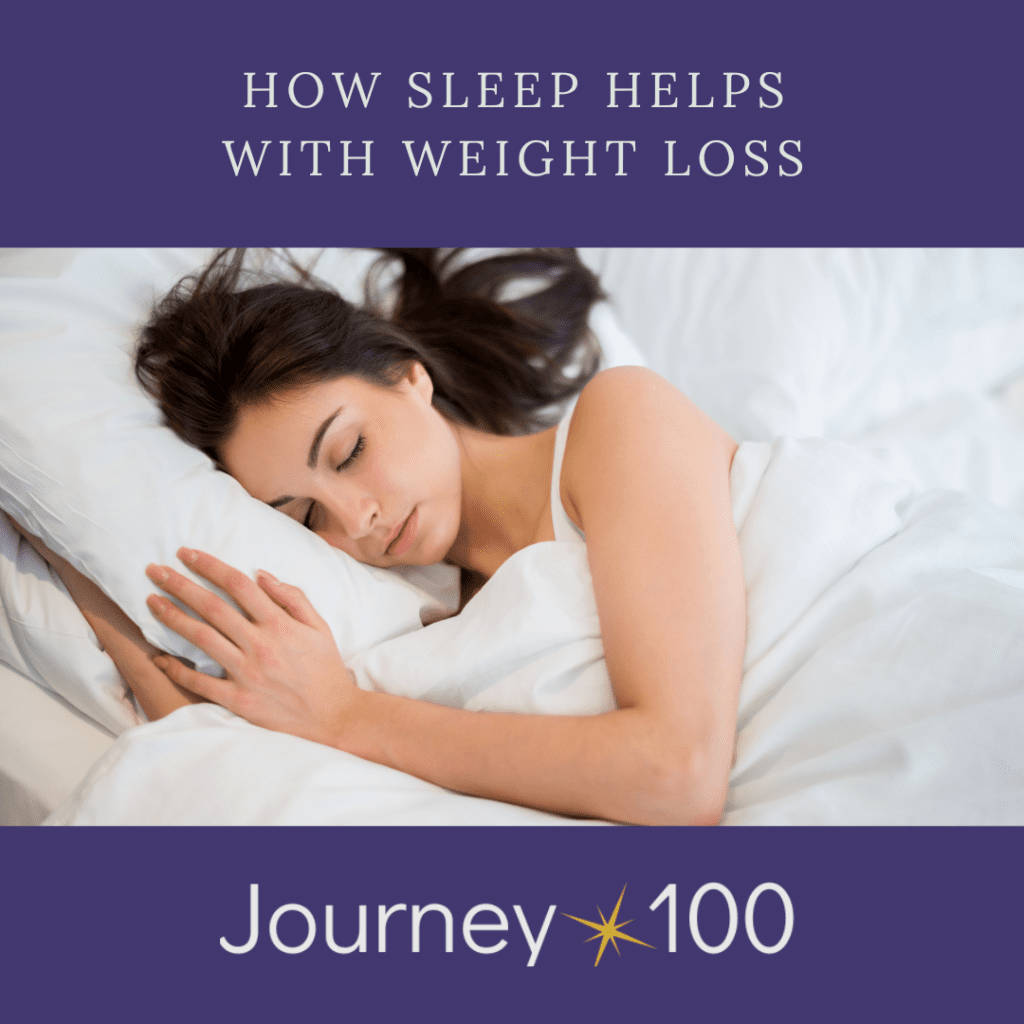
For many busy women, we find that extra time in our day to workout or meal prep by getting up earlier or staying up later. But are we actually doing ourselves a favor when it comes at the cost of our sleep? In this blog post, I will uncover for you how sleep helps with weight loss. Why Sleep Matters Metabolic Magic: Your body regulates hormones that control hunger and fullness while you sleep at night. Inadequate sleep disrupts this delicate balance, leading to increased appetite and cravings for high-calorie, sugary foods. Energy Drain: Ever notice how sluggish you feel after a restless night of sleep? Sleep deprivation zaps your energy levels, making it challenging to stay active and motivated to exercise. You are also more likely to crave those foods that give you quick bursts of energy (i.e. simple carbs and sugary foods) but don’t offer much nutritional value. Stress Sabotage: Lack of sleep can trigger stress hormones like cortisol, which not only make you feel anxious but can also lead to fat storage, especially around the belly area. How to Improve Your Sleep Habits and Your Weight Loss Now that we’ve established how sleep helps with weight loss, let’s talk about some practical steps you can take to ensure you’re getting the sleep you need. 1. Set a Sleep Schedule: More than likely, you have a routine during the workweek but it’s also important to aim for consistency on weekends too. Try to go to bed and wake up at the same time each day, even on weekends. This routine in your sleep patterns helps you fall asleep faster and wake up more refreshed as your circadian rhythm remains consistent. 2. Create a Relaxing Bedtime Routine: Wind down before bed with calming activities like reading, gentle stretching, or a warm bath. These rituals signal to your body that it’s time to get ready for sleep. I enjoy reading fiction before bed as a way to get out of my own head and get enveloped in another storyline. It helps to detach from my perceived problems or to-dos. 3. Limit Screen Time: The blue light emitted by phones, tablets, and TVs can interfere with your body’s natural sleep-wake cycle. Try to avoid screens at least an hour before bedtime. This could be a great challenge to explore new hobbies such as Zentangles, knitting or yoga. 4. Cut the caffeine: Avoid caffeine too close to bedtime. This might take a little trial and error to find the cut-off time that’s right for you. I personally stop drinking caffeinated drinks at 5pm and have found that I go to sleep much easier now at my bedtime of 10:30pm. 5. Make Your Sleep Environment Cozy: Ensure your bedroom is conducive to sleep by keeping it dark, quiet, and cool. I set our thermostat to four degrees cooler than we keep it during the daytime as well as I use a ceiling fan at night for both cooling and white noise. I even ask Alexa to turn off her screen as we go to bed and put my phone face down to eliminate extra light. 6. Manage Stress: Practice relaxation techniques like deep breathing, meditation, or gentle yoga to calm your mind before bedtime. I like journaling in the evening to help take any racing thoughts and putting them down on paper. I often tell myself that my thoughts are now written down and I can come back to them tomorrow. Celebrating Your Progress Remember, the journey to better sleep habits is all about progress, not perfection. If you’ve struggled with sleep in the past, don’t be too hard on yourself. Celebrate the small wins along the way, like going to bed 15 minutes earlier or choosing to read rather than watch TV before bedtime. These victories are building blocks toward better sleep and achieving your weight loss goal. By prioritizing restful nights and making small changes to improve your sleep habits, you’ll be better equipped to achieve your weight loss goal with energy, focus, and a clearer mind. You’ve got this! Your Coach, Andrea
How to be a Cravings HERO
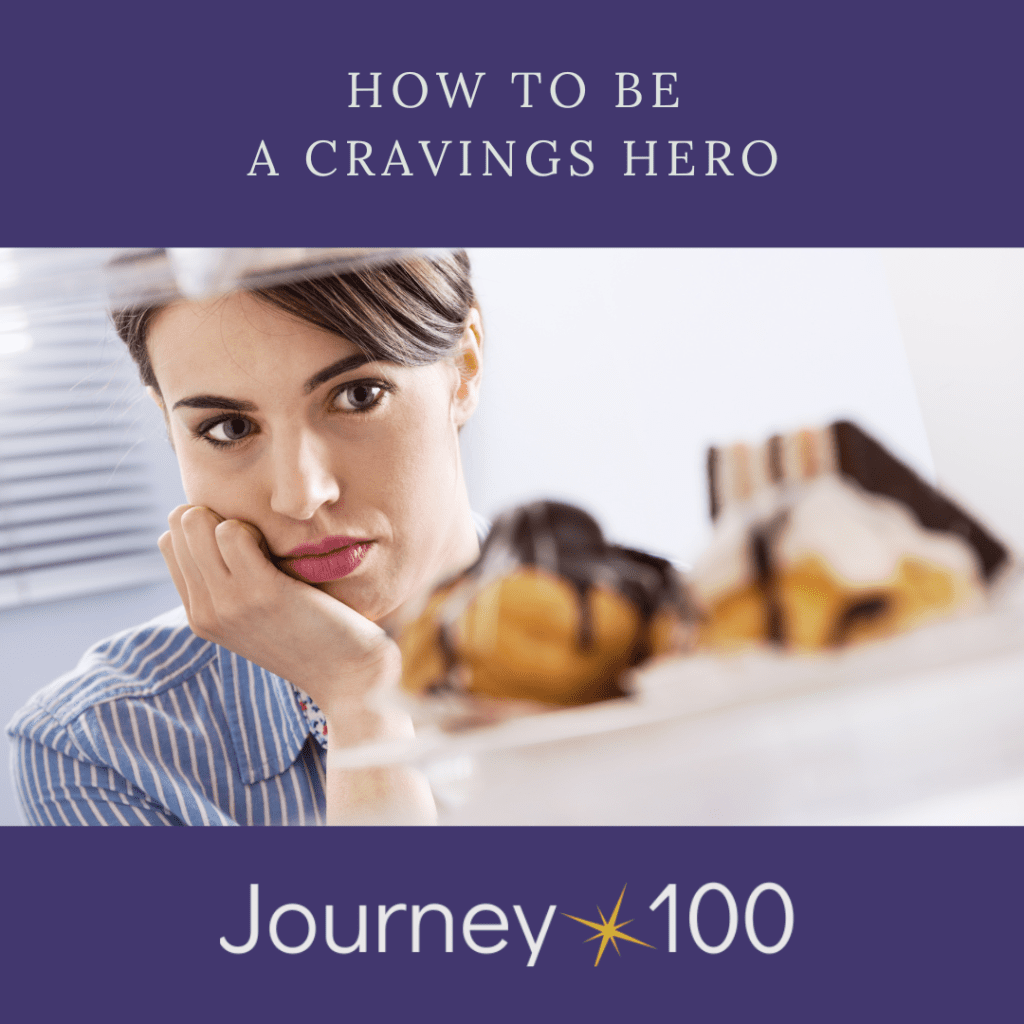
Cravings and urges for foods are a part of the human experience. But when you are trying to lose weight and urges for crave-worthy foods come up, this can cause problems for your weight loss. Below I’m going to teach you how to be a cravings hero instead of a weight loss zero. Acknowledge the craving When you have a craving, the first step to being a cravings hero is to acknowledge it. You can’t step up to be the hero until you know there is a problem. Acknowledging it isn’t hard. All you have to do is say to yourself “I’m having a craving for some chocolate” or “I’m having an urge to eat potato chips.” Acknowledging this thought it key to bringing your awareness to the situation. It helps you to start slowing down your thoughts and engaging your logical brain. There is nothing right or wrong about having a craving. It’s something that happens. Sometimes the simple act of acknowledging it and telling yourself this is normal is enough to take the pressure off. Change the scenery Yes, go somewhere else. You can make allowing a craving to pass much easier on yourself when you leave the area where you first felt that craving. Often our cravings happen in the kitchen. Take a three minute walk to the mailbox, go to your bedroom or any other part of the house. Changing the scenery gives you the time and space to consider how you want to react to that craving. It is difficult to think through your choice when the food item that triggered the craving is staring you in the face. Taking just a few minutes to go somewhere else gives you the opportunity to reset and think through how you want to respond. This is normal and temporary Often the biggest frustration about cravings is that we don’t think they should be happening. We want to pick a diet plan and stick to it perfectly without any bumps or hiccups. But that’s not real life. Bumps, hiccups and cravings are all a part of the game. You can take a lot of pressure and frustration off your weight loss journey by simply accepting that this a normal part of the process. After you remind yourself that cravings are normal, remind yourself that they are also temporary. They do not last forever. Cravings don’t just going away by giving into them. There have been many times where I have wanted some potato chips or chocolate and didn’t have any in the house. I was too lazy to go to the store and get them so I just went without it. And guess what? Eventually I stopped thinking about it and moved on. The craving went away. You’re in control Whether it feels like or not, you are always in control. If you decide to eat the food or not, you did so because you decided to. This is a beautiful thing. It’s not the delicious looking slice of cake that made you eat it. It wasn’t the bag of popcorn that moved your hand up to your mouth. You always get to decide and take action. There is no right decision either. You can decide to eat it, decide to plan for it another time or decide not to eat it at all. Those choices are available to you. Consider your weight loss goal and how each decision will affect it. As long as you like your reasons then go for it! On my weight loss journey, no foods were off limits but I made a food plan each day and if the craving food wasn’t on the plan, I didn’t eat it. I would choose to write my craving food on my plan for the next day as a way to keep my promise to myself that day but also acknowledge that if I wanted something and I could truly have it when it was planned for. Celebrate it Eating food is a pleasurable activity. When we say no to cravings because we “shouldn’t” it can feel like punishment or restriction, which is not pleasurable at all. If you decide to eat the food but followed the process above, that’s something to celebrate! If you decided to plan for the craving food for another time and delay gratification to be more intentional in your choice, another great celebration. If you decided not to eat the food now or later, wonderful! In any of these situations, you are becoming more aware and intentional in your choices and that is something to celebrate! Your coach, Andrea
Three steps to stop eating when not hungry
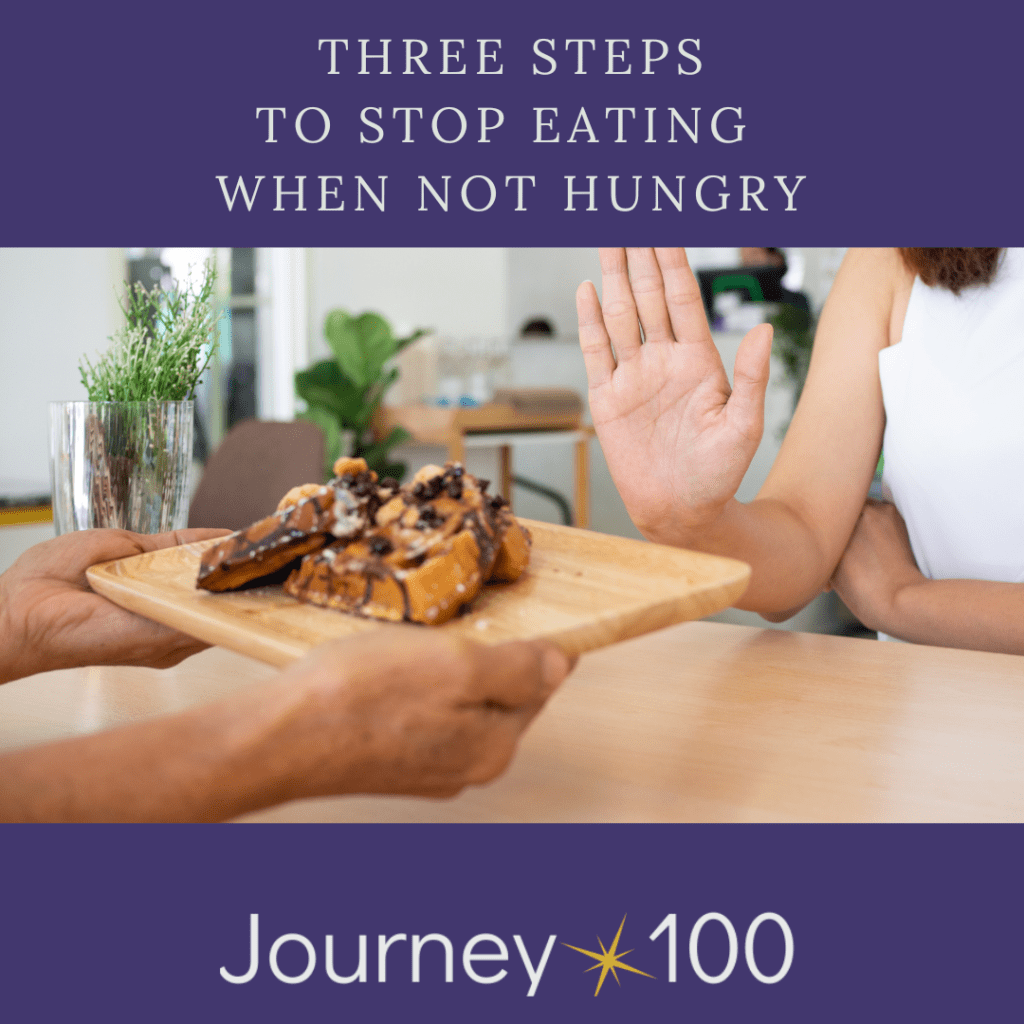
Eating when you are not hungry equals weight gain. And if you are on a weight loss journey that is a recipe for disaster! But how do you stop eating when you aren’t hungry? Follow these three steps to get back in tune with your body and stop eating when you aren’t hungry: Step One: Identify your hunger signs The first step to stop eating when you are not hungry is to figure out if you really are hungry. For many women this can actually be quite difficult. You’ve spent years eating by the clock, eating to relieve stress or eating because it simply feels good. To determine if you are physically hungry, drop into your body. What does that look like? Close your eyes. Ask yourself where do I feel hungry? For me, I know I am truly hungry when the middle of my abdomen feels a little tight. I also get slight growls in my stomach. If I have been truly hungry for a bit then the hunger starts appearing in the front of my head as a slight headache and I will feel my energy levels begin to dip. On the other hand, these physical sensations are not present when I am not hungry. Instead I will find myself “tasting” food in my mouth, like daydreaming about how good a Reese’s peanut butter cup would be right now. Sometimes when I am not hungry but WANT to eat, I will ask myself “Am I hungry?” and then soon enough I will feel a little tingle in my stomach. This is phantom hunger. It’s like a little ghost of hunger that comes pretty quickly after I get a craving for something. This isn’t true hunger. How do I know? Go to step two. Step Two: Take an inventory of your circumstance When I find myself wanting to eat when I’m not physically hungry, I take a moment to figure out what is going on in my life. One great way to do this is ask yourself “If I wasn’t going to eat right now, what would I be doing?” So often that 3pm hunger is actually being tired of work and not wanting to start another work task. In the evenings, I would be left alone with my thoughts about what I screwed up during the day, what’s left to be done tomorrow or thoughts of how I’m so exhausted and nothing really feels good in my life. Other times, I am just plain bored and want to be entertained! Once you figure out if you want to eat to avoid something in your life, then solve for that. If I am tired of work and don’t want to start another work task, then I take a 15-minute break and go for a walk, meditate or watch a couple silly tiktok videos (be sure to set a timer and don’t go beyond the 15 minutes!). If I’ve put the kids to bed and I don’t want to be left alone with my troubling thoughts, I break out my journal, jot down a quick to-do list for the next day, tell myself I’m a good wife and mother, then give myself permission to rest and relax. If I want to be entertained, then I snuggle in a blanket and watch my favorite show. Understanding what you truly need in that moment will help you understand and care for yourself better. When you start solving for what is actually bothering you, the less you will feel driven to eat at times when you are not hungry. If you’ve identified the non-food reason you want to eat when you aren’t hungry but still feel compelled to eat, continue to step three. Step Three: Do a hard reset Our brains present persistent thoughts of wanting to eat when we are not hungry simply because it is trying to avoid something in our life (see step two) AND there is not much else for it to do. On my weight loss journey, I found that continuing to push through and simply NOT eat was difficult. This was especially the case when I started working from home during COVID. I worked in the living room and thoughts about what was in the fridge started popping into my head. I’d ask myself “What would I be doing if I wasn’t eating” and the answer would generally be doing a work task. So I would acknowledge I didn’t want to do the work task, take a little break and then start the task anyway. But the thoughts kept coming. In those instances, I gave myself a protocol to help me reset. I would chug a giant glass of water, get outdoors for a five-minute walk and talk to myself. The magic in the reset is creating different sensations for yourself. The glass of water will help your body feel different on the inside (fuller and maybe colder). Getting outdoors will help you feel different on the outside (sun on your skin, wind on your face, maybe it’s warmer or cooler than your home). Finally talking to yourself. Be very specific in the things you say. This is a time to speak to yourself kindly and cheer yourself on. I often say “I’m so proud that I took this time to reset. I’m so glad that I am choosing my bigger goal over something I want in this moment. This is what self care looks like and I’m so happy I made this choice.” Final reminder: Even if you eat when you are not hungry, remember that it will never help to be unkind or berate yourself. Your weight loss journey will never be a straight line to your goal weight. Be open to learning when things don’t go as expected. If you are learning then you are always moving forward with better knowledge for the future. If you struggle with eating when you are not hungry, I can help. Schedule
Five steps to overcoming guilt over food choices
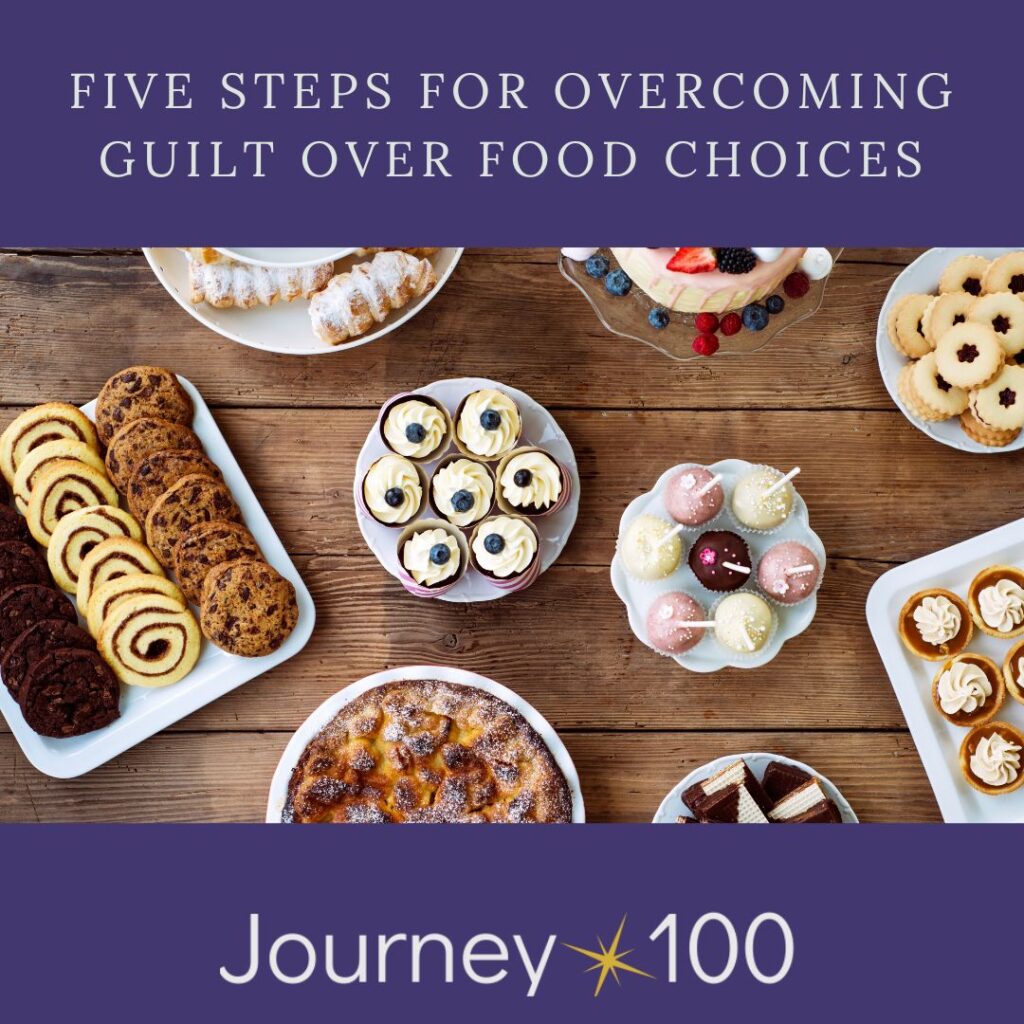
Feeling guilt over your food choices? Living in a world where the diet industry makes billions of dollars and offers contradictory information at best, it is no wonder that many of us feel that there are “good” or “bad” foods and feel immense guilt over our food choices. So how can you live a normal life eating the foods you enjoy without feeling guilty afterwards? These five steps will help you overcome guilt over your food choices: Step One: Awareness First, take an inventory of the times you feel guilty after eating certain foods. Make a list of all of those foods. If you are not quite sure, carry a piece of paper with you to make notes throughout the day of the foods you ate and how you felt afterwards. This is an important part because you need to know what the problem is to figure out the solution. Another way to get this information is through visualization. Maybe there are foods that you don’t keep in the house? Think about what it would be like to eat them. You can also visualize yourself eating things that the diet industry often calls “bad,” like sweets, candies, carbs or fast foods. If you feel guilty, put it on your list. Step Two: Normalize You are not broken if you feel guilty after eating some sweets or potato chips. It is very normal in the American culture to think of foods as “good” or “bad.” The diet industry popularized this idea to keep people following the prescribed diet they are selling. We have been taught that we are weak, uncommitted or undisciplined when we eat these “bad” foods. Even desserts are described as sinful. But this is nothing but a story that the diet industry has told us to convince us that we need their help to be successful in our weight loss journey. So be kind to yourself. Remind yourself that many people struggle with the idea of “good” and “bad” foods. And just as many feel guilty after eating certain foods too. Step Three: Be compassionate Guilt is often brought on by the way we talk to ourselves after we eat certain foods. Watch for that inner voice that uses should or shouldn’t and condemns you as a flawed person for making that choice. What would you say to a young child who ate a few too many cookies and had a tummy ache? Would you condemn them as having no self-control? Would you tell them this single act is the reason they will always be fat and ugly? I hope not. And you don’t deserve that either. That young child needs some comfort and to learn how to listen to their body the next time they eat cookies. The cookies aren’t bad but eating past the point of enough results in feeling sick. They need words of comfort and hope that the future will feel better than it does now. And so do you. Yes, maybe you over-did it on the cookies too. That doesn’t make you a terrible person. It means you also need words of comfort and hope that the future will feel better. Step Four: Retrain your brain How do you make the future feel better? Retrain your brain. Guilt is a feeling that is created when you think you have done something “bad.” Thoughts like “I’m so weak and will never be able to lose my weight” or “I knew I couldn’t control myself around those potato chips” or “I always stuff my face like a pig when we have pizza” all create feelings of guilt. The key to feeling better is to replace those guilt producing thoughts with thoughts that create hope for you. Here are some that my clients find very helpful: I’m learning to be at peace with my food choices. Today’s actions do not determine the entire course of my life. Even when I feel guilt, I can go on to make a good decision. Food is food and I’m a good person no matter what I choose to eat. Step Five: Get help Many of us have spent decades repeating the “good” food, “bad” food narrative in our heads. It takes time to unwind those thoughts and practice new ones. If you are willing to put in the daily practice you can absolutely change those narratives, heal your relationship with food and stop feeling guilty for your food choices. But sometimes the work to undo those narratives seems too difficult or you may want those results faster and that’s where I come in. As a weight loss and life coach, I can help identify those thoughts quickly and help you replace them. As a person who has lost over 93 pounds, I know what you are going through and can help you on your journey. If you want help identifying where the guilt over food is coming from, I can help you. Sign up for a 30-minute call with me today. Your coach, Andrea
Four steps to help with trigger foods
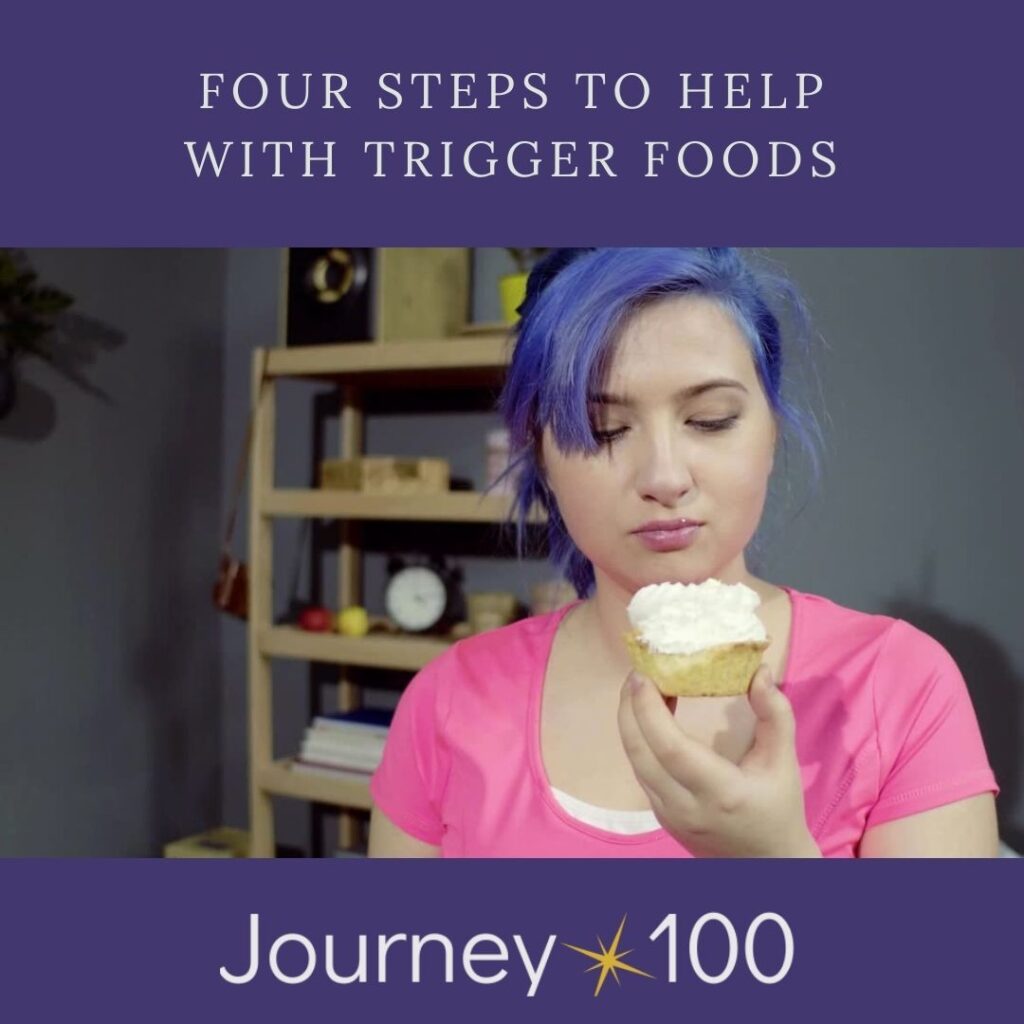
Trigger foods. Foods you can’t resist. They call out to you and beg you to eat them. Generally, these foods are not carrots, broccoli or apples. They are decadent foods. Often foods that you are forbidden because they are “bad foods” or unhealthy. You probably feel out of control around these foods and blame them for any weight gain. Never fear! If you need help with trigger foods, this post is for you. Here are four step for handling trigger foods like a boss: 1. Quit calling it a trigger food Seems simple right? But every time you call ice cream or chips your trigger food, you give all of your power away to it. It becomes a dramatic story of how this food is the downfall of your weight loss. You are powerless around it and must indulge. Calling it a trigger food puts you and your weight loss at an extreme disadvantage. Many people will tell you that they can’t keep certain foods in the house. And while this is good intentioned that doesn’t mean you will never come face to face with that food. Continuing to have this story in your mind guarantees anxiety, worry, and fearfulness about when you might come face to face with that food. It can also lead to binging on these foods when you finally get the chance because they have become forbidden even though your desire for them is high. Instead of calling them your trigger food, change the story to something more boring, like “It’s just a food you like to eat.” 2. Calm your brain down Our brains have been designed to keep us safe. Back in the times of cavewomen, this meant being able to identify ALL the problems around us that could cause us harm. Life today does not require our brains to find the mountain lion or the poisonous berries. But our brain still wants to do what it was designed to do: FIND ALL THE PROBLEMS. And guess what, your trigger food has been identified as a problem. And that’s OK. Not every problem our brain identifies is a true problem. Nor is every problem our brain identifies a reason to take action. Your brain might tell you things like: “Oh my god, there goes my diet!” “I can never lose weight and have a social life too!” “I will never be able to resist those!” “I can never stop eating….” All of those are just thoughts. Thoughts that are completely optional. Currently those thoughts are full of drama and doom. Calm your brain down by making the story boring. Remember, this isn’t a trigger food. This is just a food I enjoy eating. It can also be helpful to recognize other things you enjoy doing but are able to practice restraint around. I love going for walks on beautiful days but somehow I still manage to go to work and earn a living on beautiful days. I love spending money on cute clothes and yet each month I make sure enough remains in my account to pay the mortgage and utilities. I’m sure you have similar examples in your life. Don’t take what your brain presents you as the truth. Ask yourself if your brain is being dramatic and if you have evidence that the opposite is true as well. 3. Visualize how you want to eat them Now this isn’t a lusty visualization practice. The purpose isn’t to create more desire for the food by imagining how amazing it tastes. This visualization is to practice being around these trigger foods and imagining yourself being in control and intentional about how you eat them. My clients often feel burdened and powerless around these trigger foods. So I ask them to imagine what it would look like to be in control around them. Imagine yourself having your trigger food in your pantry. Visualize yourself going into the pantry for other things and never reaching for that food. Imagine yourself being unaffected that it is sitting there. Another visualization you can do is enjoying the trigger food. Watch yourself plate it, eat half of it and then throwing the rest out. If that causes you some anxiety, remind yourself that you are able to buy more at any time. This food is always available to you. Reminding yourself this can provide comfort that no matter what you are in charge and able to obtain that food whenever you want. It helps take away the scarcity and urgency away from that food. 4. Practice being around them Once you spend time visualizing yourself around these trigger foods, you can practice being around them in real life. Before you do, use that brain for what it was designed for! Ask it what problems might come up that could derail you from showing up as you visualized. Maybe you won’t want to stop eating it. Perhaps you eat the entire box of them. After identifying the potential problems, come up with a game plan. Maybe you start with two cookies on a plate and put the package away. Or you serve some chips and dip and then relocate to another room to enjoy them. Whatever you think might help you stick with your plan that you visualized. Then go for it! Remember, perfection is not a requirement and it is likely that you might have some overeats or completely ignore the plan all together. That’s OK. Progress has already been made by thinking it through beforehand and you’ll get more and more skilled at being around your trigger foods the more you practice. What trigger food will you practice with? Your Coach, Andrea
